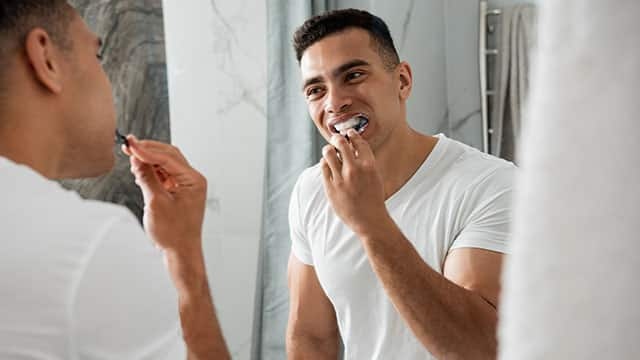What Is a Gum Stimulator?
If you’re not familiar with gum stimulators, they may look unusual to you with their silicone or rubber tip attached to a long metal arm. As the name suggests, this affordable tool may help strengthen your gum tissue by stimulating it, though it can also be used to remove plaque or food debris.
These tools aren’t considered necessary for those with healthy gum tissue, but you may still find them to be beneficial to your daily routine. They are generally recommended specifically for those with gum disease to help prevent it from worsening or spreading.
Gum stimulators can be purchased online or at many drug, convenience, or grocery stores in the dental section. If you’re unsure whether a gum stimulator would be a good addition to your oral care regimen, consult your dental professional for expert insight.
What Does a Gum Stimulator Do?
Gum stimulators are not meant to replace other parts of your oral care routine but to supplement it. Gum stimulators can help clean between your teeth, especially for those with wide gaps or missing teeth.
Gum stimulators benefit your oral health in two main ways:
- Massaging your gum tissue, helping to avoid gum disease or prevent it from worsening.
- Helping to clean between your teeth, removing food matter and plaque to prevent gum disease and cavities.
When these simple devices stimulate your gums, what exactly are they doing? Theoretically, part of what they do is help increase blood flow, allowing more oxygen to access an infection or your gum tissue. While the research on gum stimulators' effectiveness is still emerging, oxygen has been shown to help treat some cases of gum disease, according to ORAL & implantology. How much this relates to gum stimulators remains to be seen.
If you find gum stimulators make your life easier when it comes to cleaning between your teeth, this will undoubtedly positively impact your oral health. Trapped food matter and plaque also can contribute to cavities and other dental problems, so anything you can do to remove them is a safe bet.
How to Use a Gum Stimulator
One important step in ensuring your gum stimulator retains its effectiveness is to replace the tip as it wears down. Fortunately, the tips are designed to be replaceable, so you should be able to stock up on tips without having to buy a new handle.
A good rule of thumb with all types of dental care is not applying too much force to your teeth or gums to avoid aggravating your tissue or damaging your enamel. It’s important to be gentle when it comes to brushing and using flossing devices; the same advice also applies to gum stimulators.
To use a gum stimulator, you should:
- Brush your teeth for two minutes with a soft-bristled brush
- Clean between your teeth using floss, a flossing device, or an interdental brush
- Use the tip of your gum stimulator to massage your gum tissue along the gumline gently
- Slide the tip between your teeth to remove any remaining food matter or plaque
- Rinse using mouthwash or antiseptic mouthrinse
Gum stimulators are simple tools enjoyed by many as a supplement to their daily oral care routine. While the research supporting their effectiveness is still catching up, they’re generally considered safe if used gently and properly. A gum stimulator may be just the tool you need if your dental professional recommends one for gum disease, or you find them helpful to best clean between your teeth.
Oral Care Center articles are reviewed by an oral health medical professional. This information is for educational purposes only. This content is not intended to be a substitute for professional medical advice, diagnosis or treatment. Always seek the advice of your dentist, physician or other qualified healthcare provider.
ORAL HEALTH QUIZ
What's behind your smile?
Take our Oral Health assessment to get the most from your oral care routine
ORAL HEALTH QUIZ
What's behind your smile?
Take our Oral Health assessment to get the most from your oral care routine















